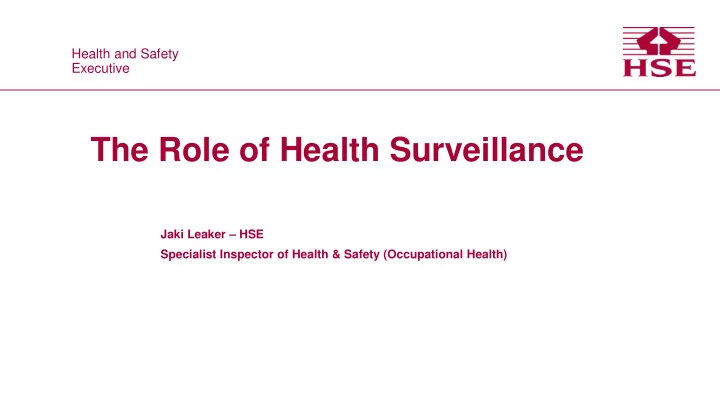

Health and Safety Health and Safety Executive Executive The Role of Health Surveillance Jaki Leaker – HSE Specialist Inspector of Health & Safety (Occupational Health)
Health Surveillance Programme • The aims of a health surveillance programme are primarily to safeguard the health of workers (including identifying and protecting individuals at increased risk), but it is also to check the long-term effectiveness of control measures. • Regulation 7 of the Control of Vibration at Work Regulations 2005 • Regulation 9 of The Control of Noise at Work Regulations 2005
What should I expect from an occupational health service provider? A suitable occupational health service provider will be able to show you that they have the training and experience needed. They should :- • Advise you on a suitable health surveillance programme for your employees • Set up the health surveillance programme • Provide suitably qualified and experienced staff to carry out the work • Provide you with reports on your employees' fitness to continue to work with noise/ vibration exposure. • You will also need to see anonymised, grouped health information, which should be made available to employee or safety representatives
HAVS – Health Surveillance • Regulation 7 of the Control of Vibration at Work Regulations 2005 requires employers to provide suitable health surveillance where the risk assessment indicates a risk to workers’ health. Workers likely to be exposed in excess of the daily exposure action value of 2.5 m/s 2 A (8) should be under suitable health surveillance. • Health surveillance should be instituted for: – Employees who are likely to be regularly exposed above the exposure action value; – Employees likely to be occasionally exposed above the exposure action value where the risk assessment identifies that the frequency and severity of exposure may pose a risk to health; and – Employees who have a diagnosis of HAVS (even when exposed below the exposure action value).
HAVS Tiers of health surveillance • Tier 1 - initial assessment for any new or existing employee before they begin exposure to HAV. • Tier 2 - Annual (screening) questionnaire • Tier 3 - Assessment by qualified person • Tier 4 - Formal Diagnosis • Tier 5 - Use of standardised tests
Stockholm workshop stages • HAVS is classified according to severity in stages (1-3) using the Stockholm Workshop scales • If carpal tunnel syndrome is diagnosed, the worker may need to be removed from exposure to vibration. Where a non-occupational condition is suspected, the employee should be referred to their general practitioner.
Noise at work – Health Surveillance • You must provide health surveillance for all your employees who are likely to be frequently exposed above the upper exposure action values, or are at risk for any reason, e.g. they already suffer from hearing loss or are particularly sensitive to damage. • Health surveillance usually means regular hearing checks, conducted annually for the first two years of being exposed and then at three-yearly intervals (although this may need to be more frequent if a problem with hearing is detected or where the risk of hearing damage is high).
Audiometry categories • The HSE has developed a categorisation scheme designed to guide the practitioner completing the test on the appropriate action to take • Category 1 – acceptable hearing ability; • Category 2 – mild hearing impairment, which may indicate developing NIHL; • Category 3 – poor hearing, suggestive of significant NIHL; • Category 4 – rapid hearing loss, changes could be caused by noise exposure or disease. • Those with category 3 or 4 hearing loss should have a medical referral .
What do I have to do with the results of health surveillance? • Keep records of the health surveillance and fitness-for-work advice provided for each employee (but not the confidential medical records which are kept by the doctor). A health and safety inspector can ask to see the health records as part of their checks that you are complying with the Regulations; • Make employees' records available to them • Act upon any recommendations made by the occupational health service provider about employees' continued exposure to health risks • Use the results to review and, if necessary, revise your risk assessment and your plans to control risks
Recommend
More recommend